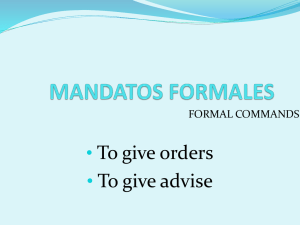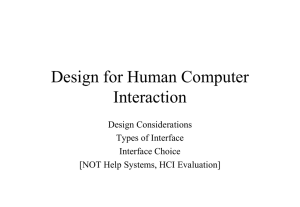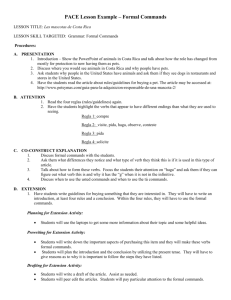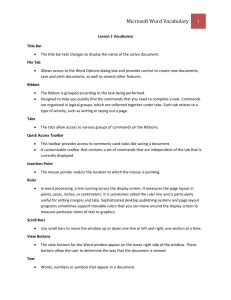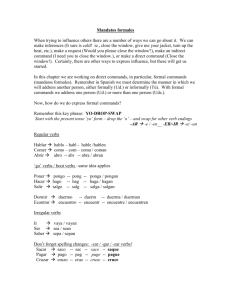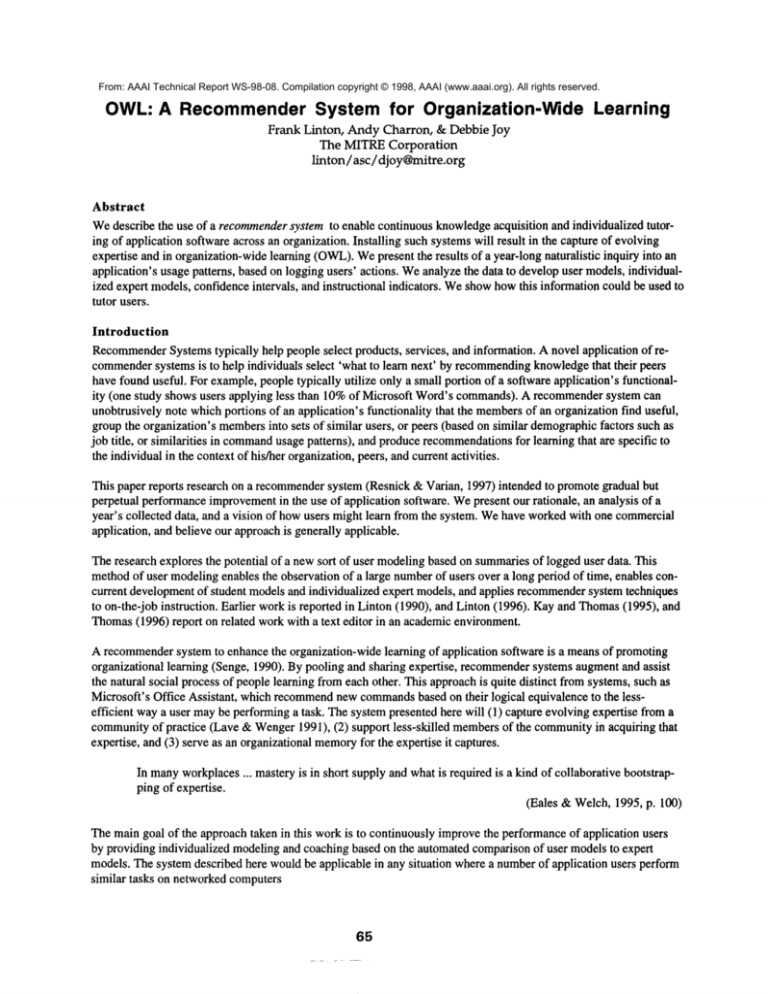
From: AAAI Technical Report WS-98-08. Compilation copyright © 1998, AAAI (www.aaai.org). All rights reserved.
OWL:A Recommender
System for Organization-Wide Learning
Frank Linton, Andy Charron, & Debbie Joy
The MITRE Corporation
linton/asc/djoy@mitre.org
Abstract
Wedescribe the use of a recommendersystem to enable continuous knowledgeacquisition and individualized tutoring of application software across an organization. Installing such systems will result in the capture of evolving
expertise and in organization-widelearning (OWL).Wepresent the results of a year-long naturalistic inquiry into
application’s usage patterns, based on logging users’ actions. Weanalyze the data to develop user models, individualized expert models, confidence intervals, and instructional indicators. Weshowhowthis information could be used to
tutor users.
Introduction
Recommender
Systemstypically help people select products, services, and information. A novel application of recommender
systems is to help individuals select ’what to learn next’ by recommending
knowledgethat their peers
have found useful. For example,people typically utilize only a small portion of a software application’s functionality (one study shows users applying less than 10%of Microsoft Word’scommands).A recommendersystem can
unobtrusively note whichportions of an application’s functionality that the membersof an organization find useful,
group the organization’s membersinto sets of similar users, or peers (based on similar demographicfactors such as
job title, or similarities in command
usage patterns), and producerecommendations
for learning that are specific to
the individual in the context of his/her organization, peers, and current activities.
This paper reports research on a recommendersystem (Resnick & Varian, 1997) intended to promotegradual but
perpetual performanceimprovement
in the use of application software. Wepresent our rationale, an analysis of a
year’s collected data, and a vision of howusers might learn from the system. Wehave workedwith one commercial
application, and believe our approachis generally applicable.
The research explores the potential of a newsort of user modelingbased on summariesof logged user data. This
methodof user modelingenables the observation of a large numberof users over a long period of time, enables concurrent developmentof student modelsand individualized expert models, and applies recommendersystem techniques
to on-the-job instruction. Earlier work is reported in Linton (1990), and Linton (1996). Kay and Thomas(1995),
Thomas(1996) report on related work with a text editor in an academicenvironment.
A recommendersystem to enhance the organization-wide learning of application software is a meansof promoting
organizational learning (Senge, 1990). By pooling and sharing expertise, recommendersystems augmentand assist
the natural social process of people learning from each other. This approachis quite distinct from systems, such as
Microsoft’s Office Assistant, which recommend
newcommands
based on their logical equivalence to the lessefficient waya user maybe performinga task. The system presented here will (1) capture evolving expertise from
communityof practice (Lave &Wenger1991), (2) support less-skilled membersof the communityin acquiring
expertise, and (3) serve as an organizational memory
for the expertise it captures.
In manyworkplaces... mastery is in short supply and what is required is a kind of collaborative bootstrapping of expertise.
(Eales &Welch, 1995, p. 100)
The main goal of the approach taken in this workis to continuously improvethe performanceof application users
by providing individualized modelingand coaching based on the automatedcomparisonof user models to expert
models. The system described here wouldbe applicable in any situation where a numberof application users perform
similar tasks on networked computers
65
In the remainder of this section we describe the logging process and makesomeinitial remarks about modelingand
coachingsoftware users. Wethen present an analysis of the data we have logged and our process of creating individual modelsof expertise. In the final section we describe further workand close with a summary.
Each time a user issues a Wordcommand
such as Cut or Paste, the command
is written to the log, together with a
time stamp, and then executed. The logger, called OWL
for Organization-WideLearning, comes up whenthe user
opens Word;it creates a separate log for each file the user edits, and whenthe user quits Word,it sends the logs to a
server wherethey are periodically loaded into a database for analysis. A toolbar button labeled ’OWL
is ON’(or
OFF)informs users of OWL’sstate and gives them control.
Individual models of expertise
Wehave selected the Edit commands
for further analysis. A similar analysis could be performedfor each type of
command.The first of the three tables in Figure 1 presents data on the Edit commands
for each of our 16 users. In
the table, each columncontains data for one user and each row contains data for one command
(Edit commands
that
were not used have been omitted). A cell then, contains the count of the numberof times the individual has used the
command.The columnshave been sorted so that the person using the most commands
is on the left and the person
using the fewest is on the right. Similarly, the rows have been sorted so that the most frequently used command
is
in the top row and the least frequently used command
is in the bottom row. Consequentlythe cells with the largest
values are in the upper left corner and those with the smallest values are in the lower right comer. The table has been
shadedto makethe contours of the numbersvisible: the largest numbershave the darkest shading and the smallest
numbershave no shading, each shade indicates an order of magnitude.
Inspection of the first table reveals that users tend to acquire the Edit commands
in a specific sequence,i.e., those
that knowfewer commands
knowa subset of the commands
used by their more-knowledgeablepeers. If instead, users acquired commands
in an idiosyncratic order, the data wouldnot sort as it does. Andif they acquired commands
in
a mannerthat strongly reflected their job tasks or their writing tasks, there wouldbe subgroupsof users whoshared
commoncommands.Also, the more-knowledgeableusers do not replace commandslearned early on with more powerful commands,but instead keep adding newcommands
to their repertoire. Finally, the sequence of command
acquisition correspondsto the commands’
frequencyof use. Whilethis last point is not necessarily a surprise, neither is it
a given.
There are somepeaks and valleys in the data as sorted, and a fairly rough edge wherecommands
transition from being
used rarely to being used not at all. Thesepeaks, valleys, and rough edgesmayrepresent periods of repetitive tasks or
lack of data, respectively, or they mayrepresent overdependenceon somecommand
that has a morepowerful substitute or ignorance of a command
or of a task (a sequence of commands)
that uses the command.In other words, some
of the peaks, valleys, and rough edges mayrepresent opportunities to learn moreeffective use of the software.
In the secondtable in Figure 1 the data have been smoothed.The observedvalue in each cell has been replaced by an
expected value, the most likely value for the cell, using a methodtaken from statistics, based on the row, column
and grandtotals for the table (Howell,1982). In the case of softwareuse, the row effect is the overall relative utility
of the command
(for all users) and the columneffect is the usage of related commands
by the individual user. The
expected value is the usage the command
wouldhave if the individual used it in a mannerconsistent with his/her
usage of related commands
and consistent with his/her peers’ usage of the command.
Theseexpected values are a newkind of expert model, one that is unique to each individual and each momentin
time; the expectedvalue in each cell reflects the individual’s use of related commands,
and one’s peers’ use of the
same command.The reason for differences betweenobserved and expected values, betweenone’s actual and expert
model, might have several explanations such as the individual’s tasks, preferences, experiences, or hardware,but we
are mostinterested whenthe difference indicates the lack of knowledgeor skill.
66
I
Observed
I
[
I
Count of COMMAND
EMPNMBR
[ __1
I
COMMAND- ~ m9371m242 m974 m375 m707 m118 m590 m926 m553 m600 m151 m000 m272 m0681m464
0
=~
EditPasteS eci ; !~
EditRedo
~:.~ ii ~4~)::~.
~!
o
o~::~2
o
0
.......
:i........
EdltGoToHeade
;..~ ’~::2
!EditCoPvAsPic
...... 0 " 8
0
EditAutoText
0
0
0
EditDeleteaack 0
0
0
EditBookmark
0
0
0"
EditGoBack
0
o o|
0
0
o ~1
o
0
.~:i
0!_
~
0|
0|
0
4;
~
0
6
o
o
0
0
0
0
0
0
0
0
0
0
0
0
0
0
0
o| o
o
-- 0
t
~ o~-_o-F7
0
0
o
0
0
0
0
0
o
0
o
0:2
o
Io
oF
o) o
Ol
01
0
0Lo~_
o
0
o. 1~
0 ; ; 2
0
0
0
0[
0
0
0
Q
0
0
o
0)
o]
0l
0_]
0Q.
01
0~
o
o
Q
0
o
oleo
0J
Of
1
0|
~l
0
O_
0
0
0
0
0
0
01
0
~1
Expec!ed
1
Count of COMMAND
EMPNMBR
I
I
/
COMMAND
Ira300 m9371m2421m974 m375 m707 n1118 m590 m9261m553 m6001m151 m000)m272 m068 m464
’
...............
~0~
o
~EditCut
EditUndo
IEditFind
~
~
~
~
~
...........
.
~!
........:.~-L~-I5
EditReolace ~ i;~i.~7
:
5’!:,
o
EditGoBack I
I--
01
0
7
:4
01
0
0
0
0
o
0
0
0
o
0
0
0
O
O
O
O
o
. " 9
3
: 3
8
2
0
0
0
i; ~ ~
i
~)
oF o
o
O
o
o
0
o
:I
0
0
0
0
_0
O_
0
0
0
0
0
0
0
0
0
0_
o
0
0
0
0
0
0
o
0
0
0
o
o
o
O
O
O
Q
O
O
0
0
0
0
0
0
0
o
o
0
O
O
o
o
¯
0
~~l~I
EditOoTo
EditCo~
EditAutoText ~i, ~::~_ 0[
EditDeleteBack
2 0
..
o
o
0
0
0
0
0
0
0
0
0 ___ D
Instruction
Count of COMMAND
EMPNMBR
COMMAND m300 m9371m2421m974 m375 m707 m118 m590 m926 m553 m6001m151 m000 m272m068 m464
EditPaste
~
nmm
EditClear
_
~~..... l_~
_
~
m ~
.... m
Edi~l
I~i~
Ed~tFind
_
EditSelectAll
|_
EditDeleteWor~
EditCopyAsPic
EditAutoText
EditDeleteBa¢l
EditBookmark
EditGoBack I
~.~
~
~
=L-
~
~1~
_
~~
---
~I_
I_
~_
-
m~
m
i
o ~ ~
o ~ ~_~1___~_~___~_~1_~__~
’
Figure1. Computing
TutorialIntervention
67
o
In the third table in Figure I, each cell contains one of five symbols.The symbolsare indicators of learning opportunities that could be used by an automatedtutoring process. Theseindicators are data that, combinedwith domain
and curriculum knowledge,wouldresult in recommendationsfor learning. The five symbolsare: "_" (underscore),
(blank), "New,""More," and "Alt." "New"has the darkest shading, followed by "More"and "Alt." The underscore
and blank have no shading.
A command
whoseexpected value is zero need not be learned, and can be ignored; its indicator is a blank. A commandthat has an expected value, but is one the individual has never used, is a command
the individual probably
wouldfind useful if s/he were to learn it; its indicator is "New."A command
whoseusage is within normal range of
the expected value can also be ignored. The normal range was determinedempirically so as to limit the amountof
recommendedlearning, on average, to two Newcommands,one More command,and one Alt command.The indicator for a command
within normal range of the expected value is an underscore. A command
that is used less than
expected maybe a componentof tasks unknownbut potentially valuable to the user; its indicator is "More." A
command
that is used more than expected mayindicate ignorance of more powerful ways of accomplishing some
tasks; its indicator is "Alt."
Providing feedback to users: Intelligent
Tips and Skillometer
Weenvision two methodsthe OWLsystem could use to provide coaching and feedback to users. An active method,
Intelligent Tips, wouldcoach passive learners; and a passive method, the Skillometer, wouldprovide information to
active learners. Both methodswouldmakeuse of the data analysis processes discussed in the preceding section, but
the Intelligent Tip interface wouldinterpret the data conservatively, sendingthe user a tip only whenit wasrather
certain of the utility of the tip to the user. For software like Word,the Intelligent Tip mightappear whenthe user
started up Word;it wouldinformthe user of the nature of the tip and point the user to the appropriate informationin
the application’s Help system. The goal of Intelligent Tips wouldbe to provide the tip with perfect timing: after the
user has becomeawareof his/her need for a command,but before s/he has madean effort to find the command.
The Skillometer (Figure 2), in contrast, wouldprovide an interface for the user to explore his/her observedand expected models, and those of any demographicgroup in the organization that the user might be a memberof, such as
Engineer, Division 40, writer-of-long-documents, etc. The Skillometer wouldmakeit easy to compareand contrast
one’s actual usage with one’s expert model, and with the synthesized expert modelsof various groups, enabling the
Figure 2. Skillometer: Skill Analysis
68
user to makedecisions for himself or herself about the utility of the commands
that others are using. The Skillometer should be useful to someonewhoanticipates performinga set of tasks and wants to becomeaware of which
commandswill be applicable.
Concluding
remarks
Wehave proposed a recommendersystem as a meansof helping a communityof practice pool and share its expertise, wherethe community
is a set of people whodesire to becomeskilled users of their application software. Expertise evolves because users respond to changes in the work environmentand to changes in the software, as well as
continuously figuring out better ways to accomplish their tasks. The system will provide continuous performance
improvementto those whodo complexjob tasks with application software. The system’s expert models will serve
as the organization’s memory
of expertise. Analysisof user log data collected over the past year revealed that editing
command
usage frequencies follow a powerlaw. As a result of this powerlaw of usage, careful work is required to
distinguish apparent user ignorance or learning from effects due solely to the amountof information logged. A
methodwas proposedfor taking these effects into account. Wefurther discovered that users tend to acquire commands
in sequence. By combiningthe powerlaw of usage with the acquisition sequence, we can determine the expected usage of each command
by each individual: an individualized expert model;and take large deviations from this modelas
indicators of ineffective software use -- and learning opportunities. Finally, we proposed two methodsof communicating these learning opportunities to users.
Bibliography
J., &Welch,J. (1995). Designfor collaborative learnability. In J. Schnaseand E. Cunnius(Eds.), Proceedings of CSCL’95: The First International Conferenceon ComputerSupport for Collaborative Learning (pp. 99106). Erlbaum, MawahNJ.
Eales,
Howell. D., (1982). Statistical
methodsfor psychology. Boston: DuxburyPress.
Kay, J., Thomas,R. (1995). Studying long-term system use; computers, end-user training and learning. Communications of the ACMVolume38 number 7.
Lave, J., and Wenger,E. (1991). Situated learning: Legitimate peripheral participation. Cambridge:CambridgeUniversity Press.
Linton, F. (1990). A coach for application software. CBTDirections(pp. 22-29), March1990.
Linton, F. (1996). Promoting the Organization-Wide Learning of Application Software. ACM
SIGOISBulletin.
Vol 17 number 3.
Resnick, P., and Varian, H. (1997). Introduction to Special Section on Recommender
Systems. Communications
the ACMVolume 40 number 3.
Senge, P. (1990). The fifth discipline: The art &practice of the learning organization. NewYork: CurrencyDoubleday.
Thomas,R. (1996). Longterm exploration and use of a text editor. Unpublisheddoctoral dissertation. University
WesternAustralia.
69



